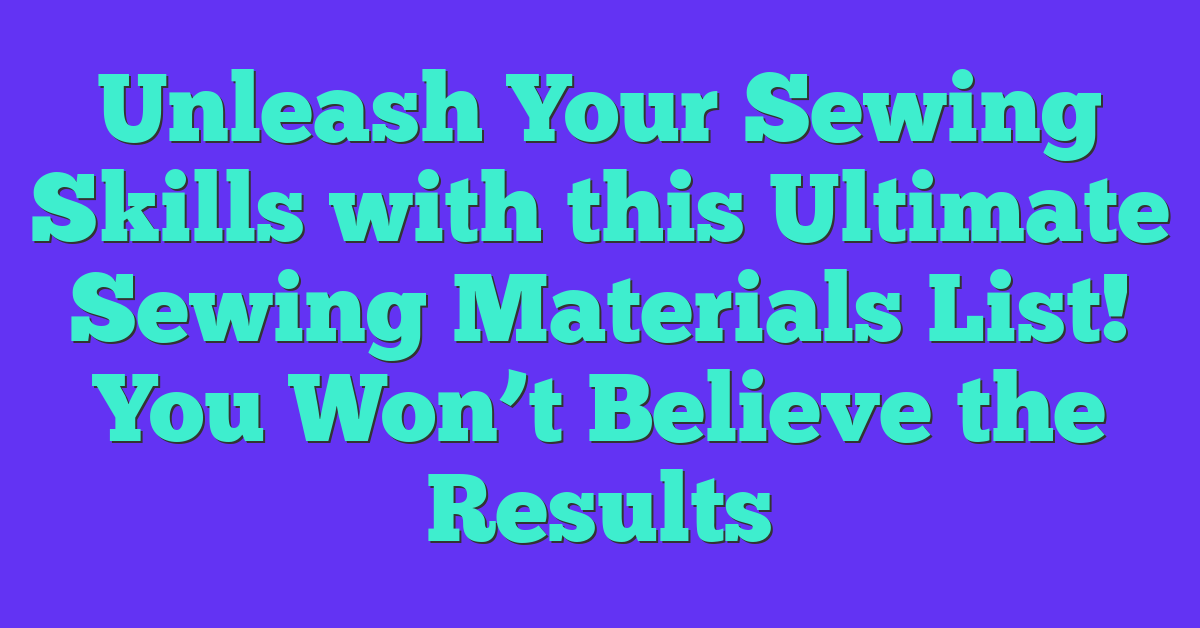Are you a sewing enthusiast looking to stock up on essential materials? Look no further! In this article, we’ve got you covered with a comprehensive sewing materials list that’s available for sale. Whether you’re a beginner or an experienced seamstress, having the right tools and supplies is crucial for successful and enjoyable sewing projects. So, grab your shopping list and let’s dive into the world of sewing materials!
Ready to embark on your next sewing adventure? Our curated list of sewing materials for sale will ensure that you have everything you need to bring your creative visions to life. From needles and threads to fabrics and notions, we’ve got all the essentials covered. Plus, we’ll also introduce you to some handy tools and accessories that can take your sewing skills to the next level. So, get ready to browse through our extensive collection of sewing materials and make your dreams a reality!
Basic Sewing Supplies
When it comes to sewing, having a set of basic sewing supplies is essential. These supplies will not only make your sewing projects easier but also help you create beautiful and professional-looking garments. Here are the must-have sewing supplies that every seamstress should have in their toolkit:
1. Sewing Needles
Invest in a variety of sewing needles, including sharp and ballpoint needles, to accommodate different types of fabrics. Sharp needles work well with woven fabrics, while ballpoint needles are designed for knits. Make sure to have different sizes of needles to accommodate various fabric weights.
2. Thread
Stock up on high-quality threads in a range of colors. A neutral color, such as black, white, or beige, is essential for basic sewing projects. Additionally, having a selection of vibrant and contrasting thread colors allows you to add decorative touches to your garments.
3. Fabric
Start with a selection of versatile fabrics, such as cotton, linen, and denim. These fabrics are easy to work with and can be used for a wide range of sewing projects. Consider purchasing fabrics in different colors and prints to add variety to your creations.
4. Scissors
Invest in a good pair of fabric scissors and keep them exclusively for fabric cutting. This will ensure that they remain sharp and provide clean cuts. Additionally, have a pair of smaller scissors or thread snips for trimming threads and a pair of pinking shears for finishing fabric edges.
5. Measuring Tools
Accurate measurements are crucial in sewing. Invest in a measuring tape and a clear ruler for precise measurements. A seam gauge is also handy for marking seam allowances and hem depths.
6. Pins and Pin Cushion
Pins are essential for holding fabric pieces together during sewing. Get a variety of straight pins and safety pins for different fabric types. A pin cushion keeps your pins organized and easily accessible while sewing.
7. Seam Ripper
Mistakes happen, and a seam ripper is a handy tool for undoing stitches when needed. Look for one with a sharp blade and a comfortable grip for easy seam ripping.
8. Marking Tools
To transfer pattern markings and make accurate markings on fabric, invest in marking tools like fabric chalk, disappearing ink pens, and tailor’s chalk.
9. Iron and Ironing Board
Pressing fabric is an important step in sewing, as it helps to create
Sewing Machines
When it comes to sewing, having the right tools is essential to bring your creative projects to life. And one tool that tops the list for any sewing enthusiast is a good sewing machine. Whether you’re a beginner or an experienced seamstress, a sewing machine can make your sewing journey much smoother and more enjoyable.
Here are a few things to consider when choosing the perfect sewing machine for your needs:

- Type of Machine: There are different types of sewing machines available, including mechanical, electronic, and computerized machines. Mechanical machines are simple and straightforward, while electronic machines offer more advanced features. Computerized machines, on the other hand, provide precise stitching and a wide range of decorative options.
- Stitch Options: Look for a machine that offers a variety of stitch options. Basic stitches like straight stitch, zigzag stitch, and buttonhole stitch are essential, but having additional decorative stitches can add a unique touch to your projects.
- Speed Control: A sewing machine with adjustable speed control allows you to sew at your own pace. This is especially useful for beginners who are still learning to control their stitches.
- Automatic Features: Consider machines with automatic features such as needle threading, thread cutting, and bobbin winding. These features can save you time and make your sewing sessions more efficient.
- Durability and Reliability: Look for a sewing machine that is built to last. Read reviews and choose a reputable brand known for producing reliable machines.
Once you have chosen the perfect sewing machine, don’t forget to accessorize it with the following items:
- Needles: Different types and sizes of needles for various fabrics and projects.
- Threads: A variety of thread colors to match your fabric choices.
- Bobbins: Extra bobbins for convenient thread changes.
- Presser Feet: Additional presser feet for specialty sewing techniques.
- Seam Ripper: An essential tool for fixing mistakes.
- Extension Table: A larger work surface for quilting and larger projects.
- Carrying Case: A protective case for easy storage and transport.
Fabrics
When it comes to sewing, one of the most important aspects is choosing the right fabric. The type and quality of fabric you use can greatly impact the final outcome of your project. Here are a few things to consider when selecting fabrics for your sewing projects:
1. Fiber Content: Fabrics can be made from various fibers such as cotton, polyester, silk, wool, and more. Each fiber has its own characteristics, so choose one that suits your desired project. Cotton is great for its breathability and durability, while silk adds a luxurious touch.
2. Weight and Texture: Fabrics come in different weights and textures, which affect how the fabric drapes and feels. Lightweight fabrics like chiffon are ideal for flowy garments, while heavy fabrics like denim are perfect for sturdy bags or upholstery projects. Consider the texture as well, as it can add visual interest and dimension to your creations.
3. Print and Pattern: Fabrics come in a wide range of prints and patterns, allowing you to showcase your personal style. Whether you prefer floral prints, geometric patterns, or something more abstract, there’s a fabric out there for you. Consider the scale and color of the print to ensure it complements your design.
« Discover the Insanely Creative Sewing Ideas for Cotton Fabric That Will Blow Your Mind
Discover the Game-Changing Secrets to Mastering Sewing Projects with Sewing Clips »
4. Care Instructions: Before purchasing a fabric, always check the care instructions. Some fabrics require special care, such as dry cleaning or hand washing, while others can be tossed in the washing machine. Consider your lifestyle and how much time you’re willing to invest in maintaining your finished project.
Remember, it’s always a good idea to wash and press your fabrics before starting a project. This helps remove any chemicals or dirt and ensures the fabric doesn’t shrink or bleed after sewing.
Threads
When it comes to sewing, Threads play a crucial role in ensuring that your stitches hold up well over time. They are the invisible heroes that hold your projects together. With a wide variety of threads available, it’s important to choose the right type and quality for your sewing projects. Here’s what you need to know:
1. Cotton Thread: This versatile thread is commonly used for general sewing projects. It comes in different weights, which determine the thickness of the thread. Thicker threads are suitable for heavy-duty sewing, while finer threads work well for lightweight fabrics.
2. Polyester Thread: Known for its strength and durability, polyester thread is a popular choice for both machine and hand sewing. It is resistant to shrinking, stretching, and fading, making it ideal for garments that require frequent washing.
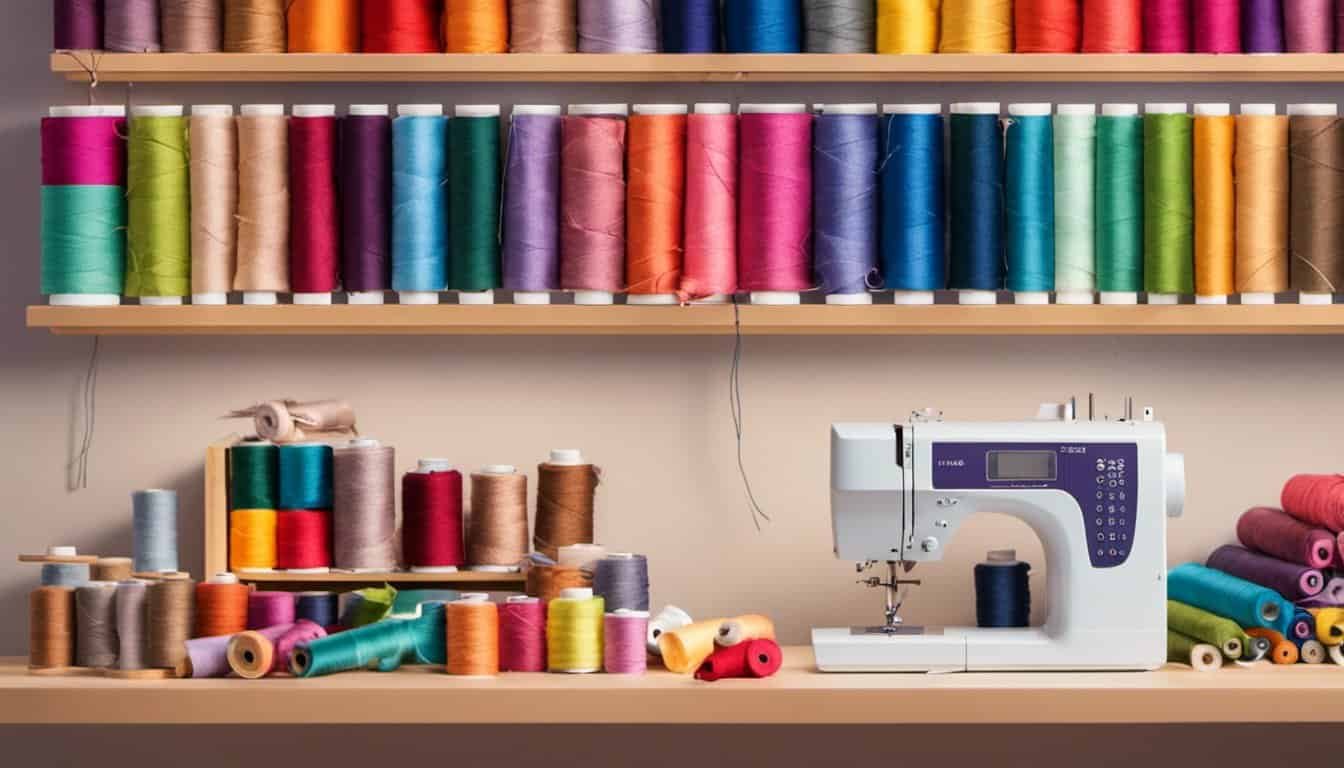
3. Silk Thread: If you’re working with delicate fabrics like silk or satin, silk thread is the way to go. It has a smooth finish and a natural sheen that blends seamlessly with these fabrics. However, keep in mind that silk thread is not as strong as cotton or polyester, so it’s best suited for lightweight fabrics and decorative stitching.
4. Metallic Thread: Want to add a touch of glamour to your projects? Metallic thread is perfect for decorative stitching, embroidery, and embellishments. It has a shiny appearance that catches the light and gives your creations a stunning look.
5. Embroidery Thread: If you’re into embroidery, you’ll need a dedicated set of embroidery threads. They come in a wide range of colors and can be used for intricate designs and decorative stitching.
Remember, always match the thread color with your fabric for a seamless finish. Additionally, consider the thickness and strength of the thread based on the specific sewing project at hand.
Needles and Pins
When it comes to sewing, needles and pins are some of the most essential tools in your arsenal. Without them, it would be impossible to bring your creative vision to life. Whether you’re working on a delicate embroidery project or stitching together a new dress, having the right needles and pins can make all the difference. Let’s take a closer look at this crucial category of sewing materials.
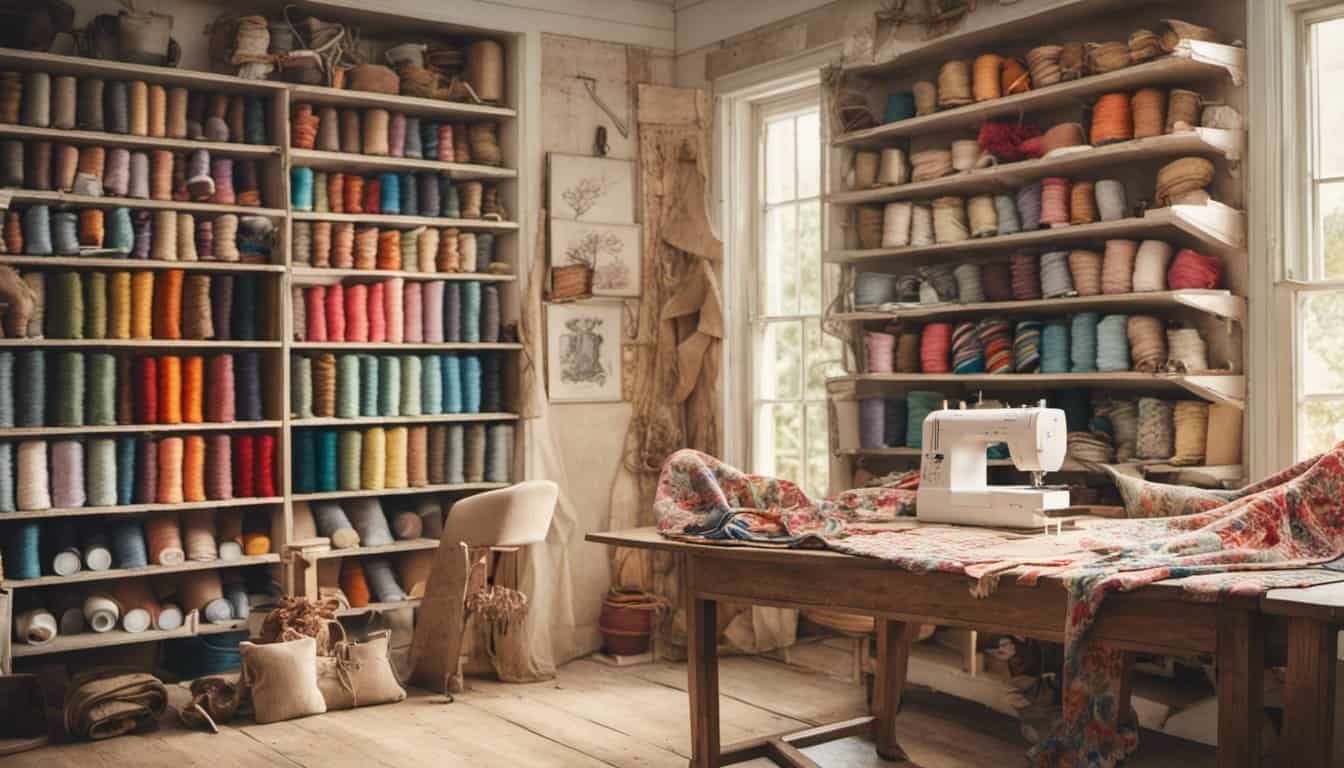
Sewing Needles
Sewing needles come in various sizes and types, each designed for specific purposes. Here are some common types of sewing needles you’ll want to have in your collection:
- Sharps: These are your go-to needles for general sewing tasks. They have a sharp point and are suitable for most fabrics.
- Ballpoint: If you frequently sew with stretchy or knit fabrics, ballpoint needles are your best friend. They have a rounded tip that glides between the fibers, preventing damage to the fabric.
- Embroidery: When it’s time to add decorative stitches or intricate designs to your projects, embroidery needles are your secret weapon. They have a long eye to accommodate embroidery threads and are available in various sizes.
- Quilting: Quilting needles are designed with a slightly larger eye and a tapered point, making them ideal for the thick layers of a quilt.
Pins
Pins are another indispensable tool for securing fabric together as you sew. There are two main types of pins you’ll want to consider:
- Straight Pins: These are the most common pins used in sewing. They typically have a sharp point and come in various lengths. Use them to hold fabric layers together before stitching.
- Safety Pins: Safety pins are handy for holding together thicker or slippery fabrics. They provide extra security and stability during the sewing process.
Having a good selection of needles and pins will ensure that you’re prepared for any sewing project that comes your way. Keep them organized in a pin cushion or a magnetic holder to prevent accidents and lost needles.
Scissors and Cutting Tools
When it comes to sewing materials, having a good pair of scissors and cutting tools is essential. They are your trusty companions in creating beautiful and precise cuts in fabric, thread, and other materials. Let’s explore some of the must-have cutting tools for your sewing arsenal.
Sewing Scissors
Investing in a high-quality pair of sewing scissors is crucial. Sharp, stainless steel blades are a must to ensure clean and accurate cuts. Look for scissors with a comfortable handle grip that suits your hand size and allows for easy maneuverability. Remember, dedicate your sewing scissors for fabric use only to maintain their sharpness.
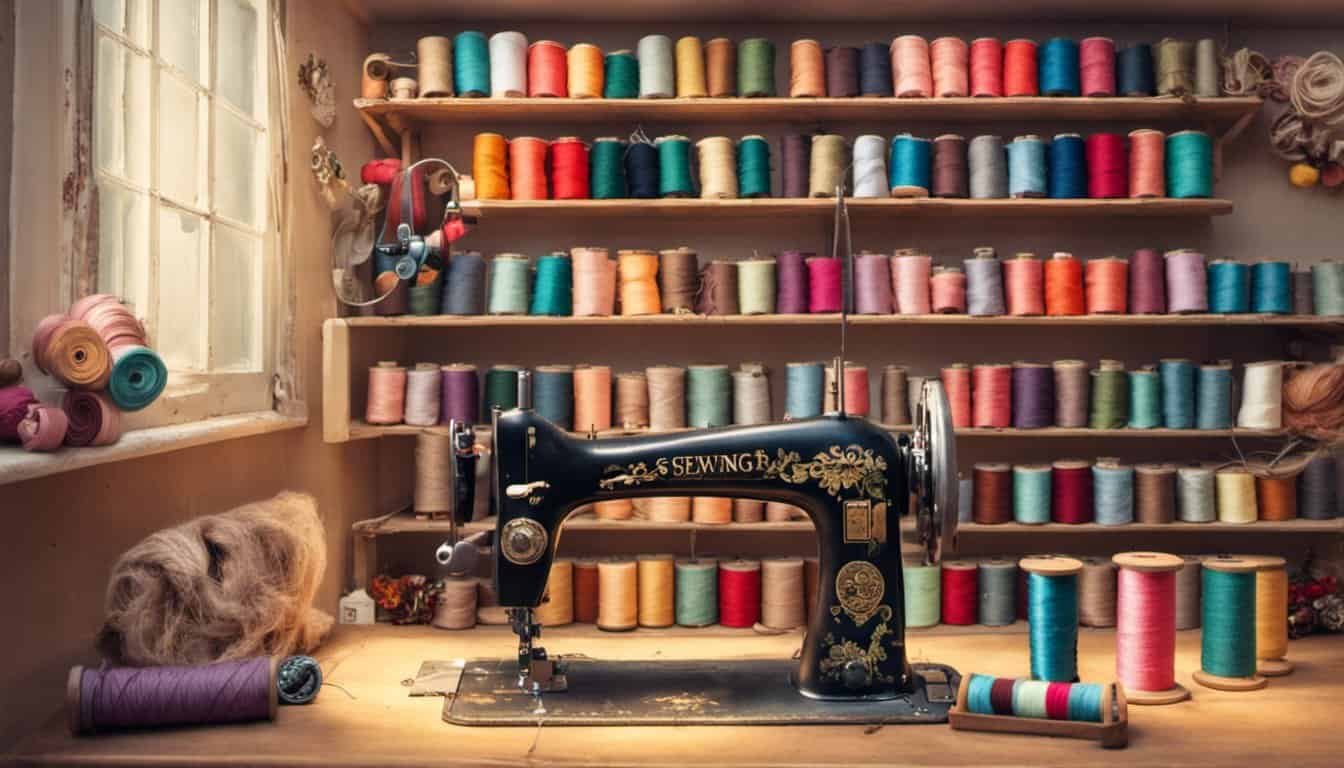
Pinking Shears
Pinking shears are a fantastic addition to your cutting tools collection. These special scissors have serrated blades that create a zigzag edge on fabric. Their unique design helps prevent fraying and adds a touch of flair to your finished projects. Pinking shears are especially useful for lightweight and woven fabrics.
Rotary Cutter
If you’re into quilting or working with multiple layers of fabric, a rotary cutter is a game-changer. These tools feature a circular blade that effortlessly glides through fabric. With a rotary cutter, you can swiftly and accurately cut straight lines, curves, and intricate shapes. Don’t forget to use a self-healing cutting mat to protect your surfaces and extend the life of your rotary blade.
Seam Ripper
We all make mistakes, and that’s where the trusty seam ripper comes in. This handy tool helps you remove stitches without damaging the fabric. Look for a seam ripper with a sharp point and a comfortable handle to make those seam-ripping sessions a breeze. Whether it’s correcting a misaligned seam or the occasional stitch mishap, a seam ripper is an absolute must-have tool in any sewing kit.
Thread Snips
Thread snips are small, compact, and perfect for quick thread trimming. These handy little tools can easily fit into your sewing box or even hang around your neck with a convenient lanyard. Their sharp blades make precision snipping a breeze, allowing you to trim stray threads and achieve a neat, professional finish.
Remember, having the right cutting tools is just as important as the sewing machine itself. They enable you to achieve clean, precise cuts and take your sewing projects to the next level. So, make sure to invest in high

Measuring Tools
Measuring tools are an essential part of any sewing project. Accurate measurements ensure that your garment or craft item fits perfectly and looks professional. Here are some must-have measuring tools for your sewing kit:
Tape Measure
A flexible tape measure is a versatile tool that you’ll use for a variety of measurements. It’s perfect for taking body measurements, measuring fabric lengths, and evaluating finished dimensions. Look for a tape measure with both inches and centimeters for maximum convenience.
Ruler
A ruler is an indispensable tool for precise measurements and straight edges. A clear, transparent ruler with markings in inches and centimeters is ideal. You can use it to measure and mark hems, seam allowances, and pattern pieces. A ruler with a handy built-in grid can also help you draw straight lines and angles.
Seam Gauge
A seam gauge is a handy tool for measuring small, precise distances. It’s perfect for measuring seam allowances, pleats, and hems. Look for a seam gauge with both inches and centimeters markings. Some seam gauges also come with a sliding marker, making it easier to mark multiple measurements without losing your place.
Hem Gauge
A hem gauge is a specialized tool for measuring and marking hemlines accurately. It usually has a curved shape with several measurements marked along the edge. Simply place the hem gauge on your fabric, adjust to the desired length, and then use it as a guide to fold and press your hem.

French Curve
A French curve is a valuable tool for creating smooth, flowing lines and curves. It’s perfect for pattern drafting, altering patterns, and adjusting armholes and necklines. Look for a French curve made of clear, flexible plastic for easy tracing and accurate results.
Remember, accurate measurements are crucial for achieving professional-looking results in your sewing projects. Invest in these essential measuring tools to ensure your garments fit perfectly and your crafts are a true reflection of your skill and creativity.
Now that we have covered measuring tools let’s move on to the next section – “Cutting Tools”.
Marking Tools
When it comes to sewing, accuracy is key. That’s where marking tools come in handy. These tools help you mark fabric with precision, ensuring that your sewing lines, darts, and other design elements are on point. Let’s take a look at some essential marking tools every sewer should have in their arsenal:
1. Fabric Markers: Fabric markers are specifically designed to make temporary marks on fabric. They come in various forms, including water-soluble markers, disappearing ink markers, and chalk pens. Choose the type that suits your fabric and project best.

2. Tailor’s Chalk: Tailor’s chalk is a traditional tool used by tailors and sewers for centuries. It’s made of colored chalk that easily rubs off fabric after use. Tailor’s chalk is ideal for marking on dark-colored or textured fabrics.
3. Tracing Paper and Wheel: Tracing paper and a tracing wheel are used together to transfer fabric markings. Place the tracing paper on the fabric and use the wheel to trace along the pattern lines. This creates marks that can be easily seen and followed.
4. Dressmaker’s Carbon Paper: Dressmaker’s carbon paper is great for transferring pattern markings onto fabric. Simply place the carbon paper between the pattern and the fabric, and trace over the pattern with a tracing wheel or pencil. The carbon paper leaves a visible mark on the fabric.
5. Marking Pens: Marking pens are another popular option for marking fabric. They come in various colors and often have fine tips for precise marking. Keep in mind that some marking pens may require heat or water to remove the marks.
6. Rulers and Measuring Tape: While not exclusively marking tools, rulers and measuring tape are essential for accurately measuring and marking fabric. Invest in a sturdy, clear ruler with both metric and imperial measurements, as well as a flexible measuring tape for taking body measurements.
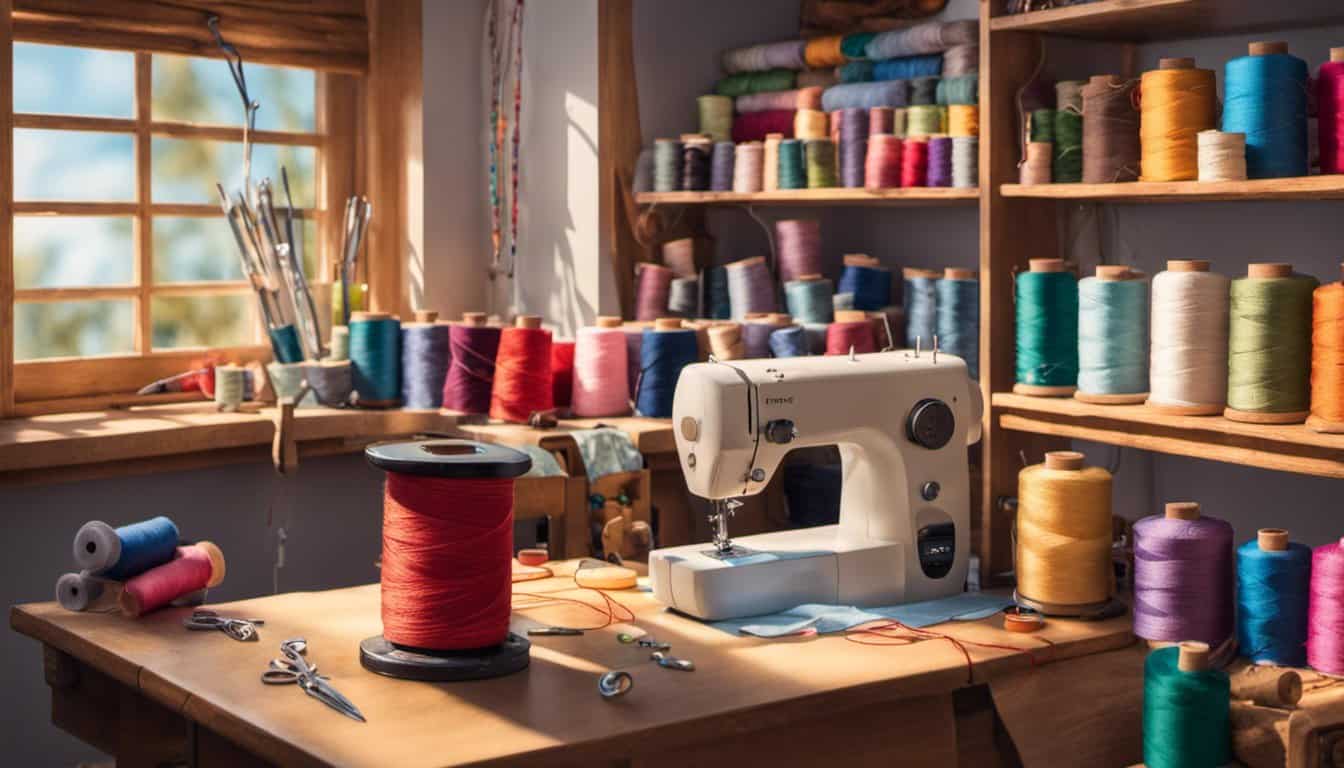
Be sure to have a range of marking tools in your sewing kit. They will make your sewing projects much more precise and professional-looking. Remember, accuracy is the key to achieving beautiful finished garments and crafts.
Continue reading to discover other essential tools and materials you need for your sewing projects.
Sewing Notions
When it comes to sewing, having the right tools and materials is essential. Alongside your sewing machine and fabric, Sewing Notions are the little things that can make a big difference in your sewing projects. From measuring to cutting to marking, these items ensure accuracy and precision in your work. Here are some important sewing notions to consider:
Measuring Tools
- Tape Measure: An indispensable tool for taking body measurements and measuring fabric lengths and widths.
- Ruler: Perfect for measuring straight lines and edges.
- Seam Gauge: A small ruler with a sliding marker that helps you measure and mark seam allowances accurately.
- Hem Gauge: A specialized tool for measuring and marking hemlines with ease.
- French Curve: Used for creating smooth and accurate curves when drafting or altering patterns.
Cutting Tools
- Sewing Scissors: Look for a good pair of sharp, lightweight fabric scissors for cutting fabric.
- Pinking Shears: Ideal for cutting fabric edges to prevent fraying.
- Rotary Cutter: A versatile tool that allows for precise and effortless cutting, especially for quilting and patchwork.
- Seam Ripper: A handy tool for removing stitches and correcting mistakes.
- Thread Snips: Small scissors or snippers that are perfect for trimming loose threads.
Marking Tools
- Fabric Markers: These pens or pencils are designed to leave temporary marks on fabric that can easily be removed or washed away.
- Tailor’s Chalk: A classic marking tool that works well on most fabrics.
- Tracing Paper and Wheel: Use these to transfer pattern markings onto your fabric.
- Dressmaker’s Carbon Paper: Great for transferring pattern markings onto fabric quickly and accurately.
- Marking Pens: Special pens designed to mark fabric with a fine, permanent line.
- Rulers and Measuring Tape: Used for marking straight lines, angles, and measurements on fabric.
Conclusion
Congratulations on completing this comprehensive list of sewing materials for sale! By now, you have learned about the various sewing machines, accessories, needles, pins, and cutting and measuring tools that are essential for any sewing project.
Remember to choose the perfect sewing machine and enhance your sewing skills with the right accessories. Selecting the right fabric and preparing it by washing and pressing are crucial steps for successful sewing. Understanding the different types of threads and their uses will help you achieve professional-looking results.

Having a good selection of needles and pins, along with essential cutting tools like sewing scissors, pinking shears, a rotary cutter, and a seam ripper, will make your sewing projects easier and more enjoyable. Accurate measurements are key, so make sure to have measuring tools like a tape measure, ruler, seam gauge, hem gauge, and French curve on hand.
Lastly, marking tools such as fabric markers, tailor’s chalk, tracing paper and wheel, dressmaker’s carbon paper, marking pens, rulers, and measuring tape will ensure precision and accuracy in your fabric marking.
With this comprehensive list of sewing materials, you are well-equipped to dive into your next sewing project with confidence. Happy sewing!

